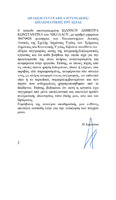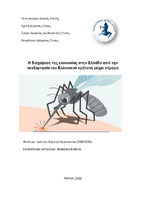| dc.contributor.advisor | Βασσάλου, Ευδοκία | |
| dc.contributor.author | Ιωάννου, Δήμητρα Κωνσταντίνα | |
| dc.date.accessioned | 2022-10-24T07:28:34Z | |
| dc.date.available | 2022-10-24T07:28:34Z | |
| dc.date.issued | 2022-10-08 | |
| dc.identifier.uri | https://polynoe.lib.uniwa.gr/xmlui/handle/11400/3206 | |
| dc.identifier.uri | http://dx.doi.org/10.26265/polynoe-3046 | |
| dc.description.abstract | Η ελονοσία είναι μια νόσος που ήταν ενδημική στον ελλαδικό χώρο από την αρχαιότητα. Μετά την κήρυξη της ανεξαρτησίας της Ελλάδας άρχισε και ο αγώνας για την εξάλειψη της νόσου από την επικράτεια. Στη παρούσα εργασία θα αναλυθεί η διαχείριση της νόσου στην Ελλάδα, από τα μέσα του 19ου αιώνα, όταν η χώρα ανεξαρτητοποιήθηκε μέχρι σήμερα. Συλλέχθηκαν δεδομένα από ποικίλες βιβλιογραφικές αναφορές, όπως ο ΠΟΥ, ο ΕΟΔΥ και δημοσιεύσεις σε έγκυρα περιοδικά από ιστορικούς και λοιπούς ερευνητές που ανέλυσαν τις προσπάθειες και τις μεθόδους αντιμετώπισης της νόσου στην νεότερη εποχή της Ελλάδας. Ο ανθελονοσιακός αγώνας πέρασε από διάφορα στάδια, που αντιστοιχούν σε διακριτές χρονικές περιόδους, με επιτυχίες και πισωγυρίσματα, που αντιστοιχούσαν σε περιόδους πολέμων, προσφυγικής κρίσης και κατά καιρούς οικονομικής δυσπραγίας του
κράτους. Ξεκίνησε αρχικά σαν ιδιωτική πρωτοβουλία, με την ίδρυση του Συλλόγου προς Περιστολής Ελωδών Νόσων, γρήγορα όμως την πρωτοβουλία ανέλαβε το κράτος. Τα προγράμματα που εφαρμόστηκαν χρησιμοποίησαν τις γνώσεις, τις μεθόδους και τα
εργαλεία κάθε εποχής. Είχαν δύο στόχους, ο πρώτος ήταν να ελέγξουν τη νόσο μεταξύ του πληθυσμού, πράγμα που επιτεύχθηκε με τη χορήγηση κινίνης για την θεραπεία των πασχόντων. Ο δεύτερος στόχος ήταν ο περιορισμός της μετάδοσης μέσω της
καταπολέμησης των κουνουπιών-διαβιβαστών. Αυτός προσεγγίστηκε με την υγειονομική διευθέτηση του περιβάλλοντος, με αποξηράνσεις των ελωδών περιοχών και τη χρήση εντομοκτόνων. Μετά τον 2ο Παγκόσμιο Πόλεμο άρχισε η υλοποίηση ενός ολοκληρωμένου προγράμματος καταπολέμησης κουνουπιών που περιλάμβανε τη χρήση του DDT. Το αποτέλεσμα ήταν να κηρυχτεί η Ελλάδα ελεύθερη ελονοσίας το 1974, και στόχος από εκεί και πέρα ήταν η διατήρηση αυτού του επιτεύγματος κατά τα επόμενα χρόνια. Η διαχείριση της ελονοσίας συνέχισε να είναι επιτυχής, με αναφορές σχεδόν αποκλειστικά εισαγόμενων
κρουσμάτων, μέχρι το 2011, όπου ενέκυψε επιδημία στην περιοχή του Ευρώτα Λακωνίας. Η επιδημία, που χρειάστηκε τρία χρόνια έντονης προσπάθειας για να λήξει, υπενθύμισε στους αρμόδιους πόσο εύκολη είναι η επανεμφάνιση της νόσου και για αυτό από το 2012 και μετά, οργανώνονται και ανανεώνονται συνεχώς σχέδια καταπολέμησης της ελονοσίας. Το τελευταίο κατά σειρά είναι μέρος του συνολικού Εθνικού Σχεδίου Δράσης Δημόσιας Υγείας. Εν κατακλείδι, ο ανθελονοσιακός αγώνας άρχισε να έχει επιτυχίες από τη στιγμή που ανέλαβε τα ηνία το Κράτος. Στην Ελλάδα υπάρχει πάντα κίνδυνος επανεγκατάστασης της ελονοσίας, γι’ αυτό και απαιτείται αυξημένη επαγρύπνηση. Σημαντικά συστατικά ενός σχεδίου αντιμετώπισης της ελονοσίας είναι η συνοχή των σταδίων δράσης του, η συστηματική παρακολούθηση της πορείας της ελονοσίας στη χώρα και η ορθή και διαρκώς ανανεώσιμη ενημέρωση του πληθυσμού. | el |
| dc.format.extent | 103 | el |
| dc.language.iso | el | el |
| dc.publisher | Πανεπιστήμιο Δυτικής Αττικής | el |
| dc.rights | Αναφορά Δημιουργού - Μη Εμπορική Χρήση - Παρόμοια Διανομή 4.0 Διεθνές | * |
| dc.rights | Attribution-NonCommercial-NoDerivatives 4.0 Διεθνές | * |
| dc.rights | Attribution-NonCommercial-NoDerivatives 4.0 Διεθνές | * |
| dc.rights.uri | http://creativecommons.org/licenses/by-nc-nd/4.0/ | * |
| dc.subject | Διαχείριση ελονοσίας | el |
| dc.subject | Ελλάδα | el |
| dc.subject | Εξάλειψη ελονοσίας | el |
| dc.subject | Σύλλογος προς Περιστολής των Ελωδών Νόσων | el |
| dc.subject | Ελονοσία | el |
| dc.subject | Καταπολέμηση ελονοσίας | el |
| dc.title | Η διαχείριση της ελονοσίας στην Ελλάδα από την ανεξαρτησία του Ελληνικού κράτους μέχρι σήμερα | el |
| dc.title.alternative | The management of malaria in Greece from the declaration of independence of the Greek state until today | el |
| dc.type | Πτυχιακή εργασία | el |
| dc.contributor.committee | Σκαναβή, Κωνσταντίνα | |
| dc.contributor.committee | Μπουλανίκη, Παρασκευή | |
| dc.contributor.faculty | Σχολή Δημόσιας Υγείας | el |
| dc.contributor.department | Τμήμα Δημόσιας και Κοινοτικής Υγείας | el |
| dc.description.abstracttranslated | Malaria had been endemic in the Greek area from the ancient time until the last quarter of the 20th century CE. After the declaration of the independence of Greece, the struggle for the elimination of malaria from the country began. The study aimed at analyzing the management of the malaria in Greece from the middle of the 19th century CE, when the country became independent, until today. Data were collected from various bibliographic references such as the World Health Organization, the Hellenic National Public Health Organization and publications in authoritative journals by historians and other researchers,
who analyzed the efforts and methods of dealing with the malaria’s course in modern Greece. In Greece, the fight against malaria went through several stages corresponding to distinct periods of time. There were successes and reversals corresponding to periods of wars, refugee crises and economic distress of the Greek state. The fight against malaria initially started as a private initiative establishing the Association for the Reduction of Epidemic Diseases that almost immediately came under government control. The applied programs used the knowledge, methods and tools of the corresponding period of time. The programs
had two goals. The first goal was to control the spread of the disease in the Greek population. The second goal was to limit transmission through the control of vector mosquitoes. The former goal was achieved by providing quinine to treat the sick people.
The latter goal was achieved by the environmental sanitation encompassing the control of environmental factors that are connected to malaria transmission such as drainage of the Greek marshes and use of insecticides. After World War II, a comprehensive mosquito control program, including the use of dichlorodiphenyltrichloroethane (DDT), was implemented. The result of the program was that Greece was declared malaria-free in 1974. From then onwards, the goal was to maintain this achievement. The management of malaria continued to be successful, with reports of almost exclusively imported cases, until 2011, when an epidemic occurred in the region of Evrótas, Lakonía. The epidemic, for which it took three years of intense effort to be over, reminded the authorities how easily the disease could re-emerge in the country. Since 2012, malaria control plans have constantly been organized and renewed. The latest malaria action plan is part of the overall National Public Health Action Plan.
Historical findings showed that, in Greece the fight against malaria began to be successful from the moment that the government got in charge. Also, in Greece there is always a risk of malaria reinstallation, which is why increased vigilance is needed. The important components of the malaria action plan are the coherence of action plan’s stages, the systematic monitoring of malaria trend in the country, and the authorities providing correct and continuously updated information to the general public. | el |



